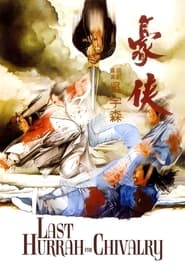Movielogr
Last Hurrah for Chivalry (1979)
Directed by John Woo
Twitter Facebook Google+Most recently watched by sleestakk, sensoria
Overview
Kao has purchased a new wife, but an enemy has paid her more money to kill him. Kao must recruit a pair of swordsmen to help defend himself and his family from his ruthless enemy. But Kao has his dark side as well.
Length 106 minutes
Actors
Damian Lau | Wai Pak | Lau Kong | Fung Hak-On | Chin Yuet-Sang | Cheng Lui | Lee Hoi-Sang | Hsu Hsia | Bonnie Ngai | Huang Ha | Wang Kuang-Yu | Cheung Ging-Boh | Wong Chi-Ming | Alan Chui Chung-San | Mars | Pan Yung-Sheng | Tai San | Chan Dik-Hak | Chui Fat | Yik Ga | Benny Lai Keung-Kuen
Viewing History (seen 1 time)
| Date Viewed | Device | Format | Source | Rating |
|---|---|---|---|---|
| 08/01/2007 | TV | DVD | Owned | 3.5 stars |
| (Average) 3.5 stars |
Viewing Notes
This originally appeared as a DVD review for PopSyndicate.com.
Judo chop!
Asian creations, whether female or fighting, fascinate Americans. Asian cinema reached a fevered import peak in the late 1970s with Bruce Lee, but the genre has been influencing American films ever since thanks to directors like John Woo, who have been giving American films an Asian flare since the early 1990s.
Last Hurrah for Chivalry is Woo’s story of Kao, a young man who is more scholar than fighter. After witnessing his family’s murder at the hands of the gangster Pai, Kao demands the right to use the mystical Moonlight Sword from his father, but is denied because the sword will not be used for evil or revenge. Still determined, Kao decides to manipulate two master swordsmen into taking revenge for him: Chang the Magic Sword, a stableboy with a penchant for chivalry and Green, a sellsword with a love for the drink. Chang and Green quickly become friends over drink and formulate a plan to obliterate Pai and his men but they quickly discover that honor is to be valued above all else after Kao’s manipulations are revealed.
Chivalry is classic kung-fu cinema delivered by John Woo in one of his earliest films. The sets are cheap, the fighters superhuman, the players over-act, the blood is more pink than red, and the sound effects are redundant and tinny. But, in classic John Woo style, the countless fights are more ballet than brawl, though not as beautiful as later, more experienced works. Thankfully, wire-fu is mostly absent in this movie. Unfortunately the story is confusing and the editing is choppy. Occcasional sequences also seem out of place; characters may be wearing one kimono in one scene, a different one in the the next, and then in the next scene the character is wearing the first kimono again. Although levity is needed to balance out what is ultimately an extremely dark story, at times it’s too much, bordering on the wacky.
The film has been restored beautifully. All scratches have been removed from the film and the sound is faithful to what I would expect from the first time the film was ever shown. Special features include two insightful interviews with the two main villains of the film: Lee Hoi-San (Pai) and Fung Hak-On (Pray). Both interviews tell of the young John Woo and how he was changing Chinese film culture at the time, as well as how details of the training and fighting. There’s also a spectacular special feature on ancient Chinese weapons with Asian cinema and martial arts expert Bey Logan. It’s a shame that Woo was not involved in any of the features. Having met him in person, he’s an amiable and funny man and would have provided a spectacular interview.
John Woo is hardly the only Asian cinema director whose classic films deserve to be restored, and he won’t be the last. These films have already inspired many American auteurs like Quentin Tarantino. They deserve the chance to inspire a new generation.

No comments yet. Log in and be the first!